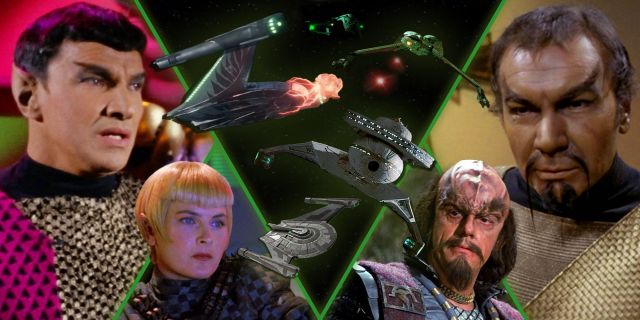Quick Links
- How Are Romulan And Klingon Starships Similar?
- Did The Klingons And Romulans Have A Military Alliance?
- Have Klingon And Romulan Ships Ever Fought In Star Trek?
Highlights
- The Romulan and Klingon empires are the major forces in the Beta Quadrant and have a long history of complex relations with the Federation and each other.
- Both empires utilize cloaking technology, and this is vital to understanding their interactions, alliances, and military strategies.
- While there have been many skirmishes between Romulan and Klingon ships, hardly any conflicts have been depicted on screen.
Fans of Star Trek who grew up with The Next Generation or later series may think they know the relationship between Romulans and Klingons inside out. It’s not good, with the two species even called “blood enemies.” That phrase was painfully illustrated in the third season TNG episode, ‘The Enemy,’ in which Lieutenant Worf refused to grant a life-saving blood transfusion to a Romulan, and the dying Romulan wasn’t willing to accept it. Things were bad, but that’s not the whole story of two alien races who have been a significant part of Star Trek since the beginning.
The Federation sits precisely between the Alpha and Beta Quadrants, with the Romulans and Klingons their dominant neighbors on the Beta Quadrant. History suggests that relations between the two are influenced by how either gets on with the Federation. Still, details of conflict and alliances are surprisingly rare. As Star Trek has jumped periods, the canon has scooted around the issue at impulse power, filling in but also contradicting events. However, what evidence there is that a link exists between the two is mainly found in the two empires’ space fleets.
How Are Romulan And Klingon Starships Similar?
Fans first encountered the Romulans in a thrilling early episode of the Original Series. ‘Balance of Terror’ referenced a devastating Human-Romulan War in the 22nd century, but this was the first time the races had ever seen each other. The explanation was a lack of viewscreen technology during the war, an idea prequels have struggled with in the decades since.
The episode was a memorably taut game of cat and mouse between the Enterprise and a Romulan Bird of Prey that would heavily influence Star Trek II: The Wrath of Khan and even be replayed in a parallel timeline in Star Trek: Strange New Worlds. One of the most memorable parts was the Romulan ship, which sported a stunning full mural of a bird on its ventral hull. Its threat wasn’t in doubt, having destroyed several Federation outposts, and its markings and agility immediately associated the Roman Star Empire with predatory birds.
Klingons wouldn’t appear for another 12 episodes, and their ships weren’t seen until Season 3’s ‘Day of the Dove’ (although recent remasters have added them to earlier episodes). However, the eye-catching D7 battlecruiser featured a long neck and wings, becoming a design classic and earning an origin in Star Trek: Discovery.
While the D7 design resembled a bird, it was still a surprise when the Romulans were shown to be using the ships in the third season of the Original Series. As Spock quickly explains in ‘The Enterprise Incident,’ “Intelligence reports Romulans now using a Klingon design.” The giveaway on the Romulan variants of the D7 was red and yellow feather motifs on the grey hull.
After the leap to movie theaters, a new design of Klingon ship debuted in Star Trek III: The Search for Spock before it took a vital role in the classic time-traveling installment that followed. Commanded by Kruge, it was a new green Bird of Prey, but it wasn’t Romulan. This iconic new design was to become the Klingon Empire’s most ubiquitous ship well into the 24th century of The Next Generation.
When the Romulans roared back at the end of TNG’s first season, it was hard not to see their new ship as a statement. By the time of ‘The Neutral Zone,’ the Romulans had been in isolation for over 50 years, but they hadn’t stopped working on their fleet. When it uncloaked, the gigantic Romulan D’deridex-class Warbird dwarfed the Enterprise-D and would become the intimidating lynchpin of their space fleet over the following decade.
The Romulan Warbird gained a fascinating new perspective when Enterprise introduced a previously unknown Klingon Warbirds in the 22nd century. These appeared during the pilot ‘Broken Bow,’ which recounted the problematic first contact with the Klingon Empire and would appear in the Kobayashi Maru scenario of the Kelvin timeline.
By the 24th century, when Deep Space Nine showed us more of the Romulan and Klingon fleets than ever, the two species were sworn enemies, and the strange crossover in technology and ship naming conventions remained unexplained. However, in the rich fabric of Star Trek, there are plenty of answers to be found.
Did The Klingons And Romulans Have A Military Alliance?

During Deep Space Nine, the threat of the Dominion forced an alliance between the Federation, Klingons, and Romulans. However, it doesn’t appear to be the first time the great powers of the Beta Quadrant found an advantage in working together. Aside from the designs and names of their ships, the two were united by their use of cloaking devices. While Klingons often dismiss the Romulans as untrustworthy, that technology is too good to overlook and allows the warrior race to pounce on its prey.
Fans saw cloaking technology firsthand through the Klingons thanks to the Bird of Prey that Kirk and crew commandeered when they time-traveled back to 1986 in Star Trek IV: The Voyage Home.
For years, it was generally accepted that Romulans pioneered cloaking technology. ‘Balance of Terror’ was considered Starfleet’s first proper encounter with cloaking technology, but prequel series haven’t been able to avoid diluting or contradicting this. The reputation stood in the 24th century when the Romulans allowed the USS Defiant to be kitted with a cloaking device from Deep Space Nine’s third season.
Enterprise revealed several enemies had used cloaking technology during Starfleet’s formative years. The shows’ creators have expressed regret they let the tech creep into the Romulan arsenal in the 22nd century, but Star Trek Discovery also raised questions when it showed Klingons using cloaking technology as early as 2256.
There has been plenty of evidence that Klingon and Romulan cloaking technology differs. That’s covered perceived Romulan superiority with the technology, the level of imperfection when cloaks are active, and even, as mentioned in Deep Space Nine, the weight of the device. Still, it’s central to any idea of a Romulan-Klingon pact. It was an infiltration mission to gain access to the Romulans’s powerful new and improved cloaking technology in ‘The Enterprise Incident’ that first revealed Romulans using ships of Klingon design. Expanded universe information has been keen to reinforce that link.
In Star Trek V: The Final Frontier, it’s revealed that the Klingons, Romulans, and Federation established a joint colony on Nimbus III in the spirit of “galactic peace” in 2267. It clearly worked out better for two of the parties, given that this was just one year before ‘The Enterprise Incident.’
The Star Trek: The Next Generation Technical Journal states that the Romulans traded a cloaking device with the Klingons in exchange for several D7 cruisers. The Klingon Bird-of-Prey Owner’s Workshop Manual expands on that, suggesting that cloaking was rolled out through the Klingon fleet after the exchange (explaining why Klingons don’t demonstrate the ability during the Original Series), but that the technology diverged after the alliance collapsed.
We saw that Klingons had solved the power problems that prevented firing under cloak by the time of Star Trek VI: The Undiscovered Country (2293). The Romulans wouldn’t demonstrate the same ability until the Reman takeover of the Romulan Star Empire revealed the gigantic warbird Scimitar in Star Trek: Nemesis (2379).
If there was a deal before the third season of the Original Series, it seemed stacked in the Klingon empire’s favor. However, prequel series suggest it was unlikely to be the first time the technology was shared. As the Romulan Star Empire’s primary goal has always been to disrupt and delay the expansion of the Federation in the Beta Quadrant, it’s understandable they would have explored all options since humanity achieved warp flight and drew links to the Vulcans.
The real reasons behind similarities and gaps in explanation were far more prosaic. There’s some suggestion that any fourth season of the Original Series would have explored the idea of a Klingon and Romulan alliance, and when that didn’t happen fans were just left with heavy hints.
On the big screen, the similarity was down to a last-minute change of villain. The Search For Spock seemed readymade for the Romulans, as the movie saw the rescue of the most famous Vulcan, and it would have been a great precursor to later storylines about reunification between the two races in TNG and Discovery. However, director Leonard Nimoy, the first cast member to direct Star Trek, favored the more theatrical Klingons as the film’s threat. It was to be a starring moment for the warrior race after their new aesthetic and forehead ridges were introduced in a cameo at the beginning of Star Trek: The Motion Picture.
The film seized the chance to add a new dimension to its villains. The new-look Klingons were set in stone by Christopher Lloyd’s Commander Kruge, and the Romulans were forgotten. The Klingon Bird of Prey remained. Decked in green with swooping wings, it was well-named but a leftover from earlier scripts that set up the Romulans as foes.Writer Harve Bennett suggested he deliberately kept the ship’s name after picking up on the plot point of technology sharing in the Original Series.
The writers can take the blame for the Klingon Warbird that appeared early in Enterprise, too. Braga confirmed to Star Trek magazine that it was a writer mix-up, where Bird of Prey had been intended, but Warbird made it to the shooting script.
Have Klingon And Romulan Ships Ever Fought In Star Trek?

The show has never shown us a war between the empires on the scale or reputation of the Human-Romulan or Federation-Klingon war. But skirmishes have been mentioned. In the Deep Space Nine episode ‘Blood Oath,’ Kor recalls a memorable victory over the Romulans at the Battle of Klach D’kel Brakt in 2271, suggesting any Romulan-Klingon pact during the Original Series can’t have lasted long. The subsequent inconsistent mentions of conflict are most easily explained by a series of on-off alliances.
In the TNG episode ‘Reunion,’ Geordi La Forge mentions that the Romulans and Klingons saw each other as “blood enemies” by 2292. Star Trek VI: The Undiscovered Country, set a year after that date, saw the Romulans attempt to sabotage the Khitomer Accords between the Federation and Klingon Empire that would lead to the alliance of the 24th century. That was another failed plot by the Romulans that only helped Earth form alliances against them.
Subsequent skirmishes recorded in canon include the Romulan attack on a Klingon colony on Khitomer that killed Worf’s parents. The Enterprise’s Security Officer suggests that the attack went some way to painting Romulans as traitors as they were still considered allies in 2346. Three decades later, TNG’s season 5 revealed that the Romulans were purposefully seeking to influence the Klingon civil war.
Star Trek history would throw disaster at both the Klingons and Romulans, forever changing their role in the galaxy. The destabilization caused by the destruction of the moon Praxis forged the way for an alliance between the Federation and the Klingon Empire. A century later, the destruction of Romulus would inadvertently create the Kelvin timeline and set up the galaxy for the time of Star Trek: Picard. The galaxy remains unpredictable, including the relationship between the two great empires of the Beta Quadrant.











Leave a Reply